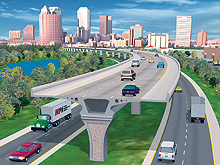
honolulutraffic.com
Offering cost-effective ways to reduce traffic congestion in Honolulu
Public transportation's loss of market share since 1920
Public Transportation has been losing market share to the automobile since 1920 aside from World War II when rationing and shortages temporarily changed the situation. As can be seen from the chart below, for a brief period in the 1970s and early 1980s public transporation grew with population. However, as gas prices dropped from their highs and as motorists downsized the vehicles they were driving, so public transportation continued its see-sawed sideway progress.
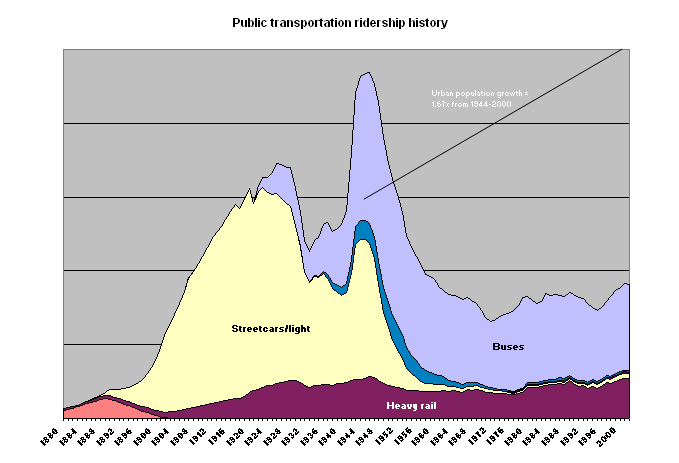
Data sources: APTA.com; Historical Statistics of the U.S. to 1975.
Of course, at the first sign of an upturn the public transportation cartel across the country begin picking anomailies among the transportation statistics to show that public transportation has caught fire. It has not. The latest data from the American Public Transportation Association (APTA), the industry's own organization, is that from the 1st quarter of this year and shows a 3.4 percent increase nationally.
This is about the same as we are showing locally. Considering that gas prices have risen considerably while bus fares have stayed the same since 2003, this is hardly surprising. However, it will not last. Local residents will downsize their vehicles to whatever it takes to get them back in their cars. Do not think of "cars," think of individual transportation which saves you time and money and frustration.
Another indicator is the U.S. Census data, which gives us a more accurate idea of trends in commuting. The APTA data measures "boardings" — which counts the number of times a person boards a transit vehicle. This number can be quite misleading — see boardings.pdf
The Census data on the other hand deals only with commuters as individual asking them how they normally travel to work. As you can see from the next chart. Commuting by public transportation has about leveled off at six million people but the population has been increasing and so the market share keeps declining.
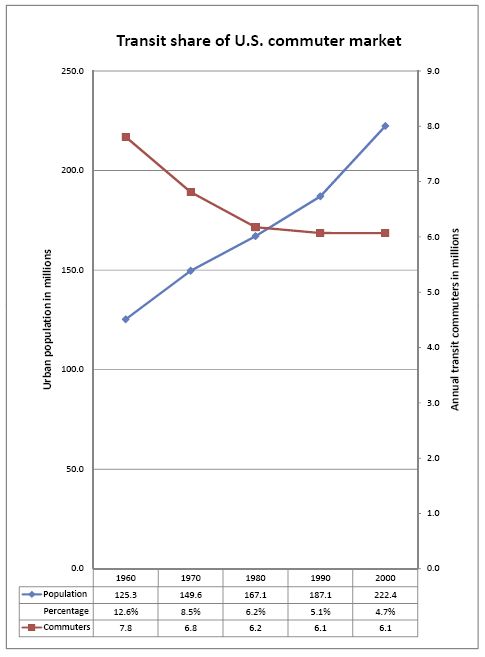
Locally in Honolulu bus ridership has been following the national pattern. Per capita ridership peaked here in 1984 after a flurry of subsidy increases following the socialization of our bus system in 1972. Up to that point it had been a profitable, private operation — albeit heavily regulated. Once it was in the public sector, service was expanded so that you could go around the island for $2, special buses were bought to get up into the hills, and all kinds of uneconomical service introduced. After there was nothing more to expand into, ridership declined in a see-saw fasion to current levels despite a 20 percent increase in buses. Of course, population grew and so market share declined considerably. (Data source)
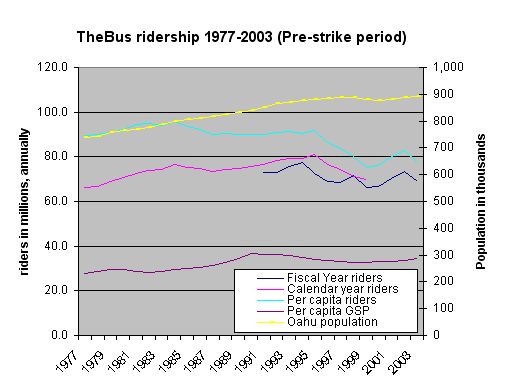
Local commuting data from the Census shows a similar pattern as can be seen from the data below. Public transportation commuting has declined slightly while the work force has grown and therefore we have experienced a decline in market share.
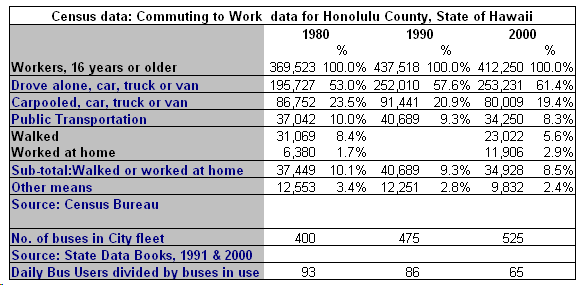
Of course, the authorities are trying to pretend this is not happening and so at every juncture where forecasts of future bus ridership have to be made the consutants (usually Parsons Brinckerhoff) will forecast a 30 percent increase. That does not happen; ridership slips slowly sideways or down.
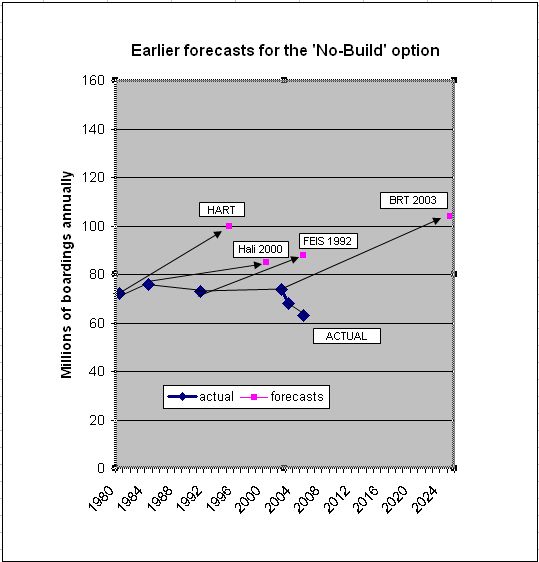
SUMMARY:
There is an underlying decline in the use of public transportation in the U.S., Europe and everywhere there is a relatively free economy. People know they will save time/money (time is money) and frustration when they can use individual transportation — an automobile of whatever size. Only elected officials can talk about public transportation as a Quality of Life issue; for normal human beings our cars are quality of life.
The fanatics who are trying to force us out of our cars try to paint our resistance to it a right wing conspiracy funded by oil and gas interests. However, the Progressive Policy Institute, the organ of the Democratic Party Third Way group has this to say in their “The Politics of Gridlock” which was written by Rob Atkinson, Vice President of PPI. He says,
“It would be easy to underestimate the influence of the anti-auto coalition. Through masterful use of rhetoric and oversimplified analysis, they have succeeded in dramatically influencing not just federal, state, and local policies, but the entire orientation of the transportation debate. Terms and phrases like “smart growth,” “increasing access to choices instead of building freeways,” and “sustainable, holistic solutions” sound great. Yet for much of the movement, these are code words that mask an anti-automobile, anti-highway agenda.” P. 122.
“For this ‘third way’ to succeed, it will have to … focus on expanding the supply of transportation, including building and expanding roads, making the current system more efficient (including instituting pricing mechanisms and using intelligent transportation technology of all sorts).” P. 127.
“… with most Americans preferring single-family homes, and with new information technologies giving businesses more locational freedom, the old economy’s urban-centered system will never be revived. As a result, it makes no sense to have a transportation policy predicated on a view of the world that looks backward, not forward.” P. 127.
“The anti-road coalition has incorrectly diagnosed congestion as a problem of too many cars. Influential, but misguided analysts, like Brookings Institution’s Tony Down[s], author of Stuck in Traffic, and countless environmental advocates have led most Americans to incorrectly believe that infrastructure expansion will not reduce congestion. Moreover, the anti-supply forces actively oppose expansion of transportation infrastructure. Given this fierce opposition to the expansion of roads and highways, it is no wonder that transportation officials take the easy way out: adding HOV lanes, repairing roads and bridges instead of building new ones, improving the aesthetics of highways, etc. Progressives should define congestion as a problem of inadequate infrastructure. They should support an array of policies designed to give Americans the world-class transportation infrastructures they deserve, including public transit, biking and walking trails, and expanded and less congested roads.” P. 128.